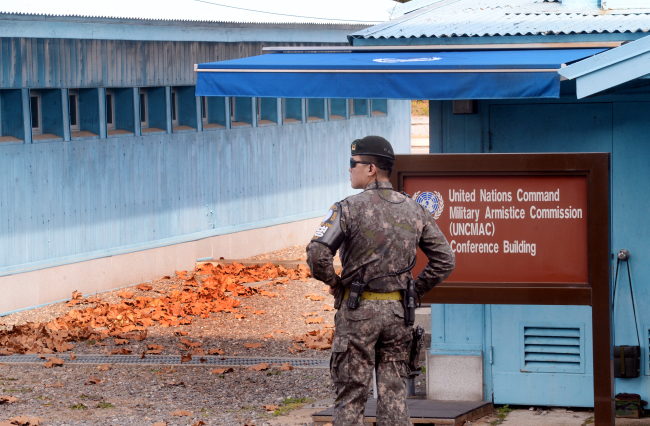Changes afoot at JSA
‘Scariest place on Earth’ to become weapons-free zone where two Koreas’ soldiers move freely
By Yeo Jun-sukPublished : Oct. 23, 2018 - 15:56
When the Joint Security Area was established in 1953 after the Korean War ended with an armistice agreement, the 800-meter-wide area was the only place where the two Koreas’ soldiers could move freely across the border.
The soldiers were allowed to cross the Military Demarcation Line and enter areas under the other side’s control. Private conversations and bartering were frequent until strictly forbidden after the horrendous ax murders of two US soldiers by North Korea in 1976.
Boosted by the inter-Korean detente that has led to a series of military confidence-building measures, the two Koreas are seeking to return the JSA to its original state by demilitarizing what former US President Bill Clinton once described as the “scariest place on Earth.”
The soldiers were allowed to cross the Military Demarcation Line and enter areas under the other side’s control. Private conversations and bartering were frequent until strictly forbidden after the horrendous ax murders of two US soldiers by North Korea in 1976.
Boosted by the inter-Korean detente that has led to a series of military confidence-building measures, the two Koreas are seeking to return the JSA to its original state by demilitarizing what former US President Bill Clinton once described as the “scariest place on Earth.”

“In accordance with the armistice agreement, the two Koreas will change the JSA into a place for peace and reconciliation,” the Ministry of National Defense said in a report released after the two Koreas signed a comprehensive military agreement following the inter-Korean summit last month.
When the armistice agreement was signed, the signatories designated the JSA as a neutral place inside the heavily fortified Demilitarized Zone. Carrying firearms and heavy weapons was prohibited inside the JSA, though the principle had often been violated due to the turbulent security environment.
Making the JSA a weapons-free zone, therefore, is the priority for the two Koreas’ militaries and the US-led United Nations Command, who signed the armistice agreement. They agreed to remove firearms and guard posts by Thursday after completing the removal of land mines near the JSA.
Eventually, soldiers from the two sides will be allowed to cross the MDL marked by a concrete slab and enter each other’s zone freely without carrying guns. They will wear armbands that say “Military Police of Panmunjom,” the border village inside the JSA where the two Koreas have recently held two summits and various talks.
“Even when free movement was allowed inside the JSA before the ax murder incident, the US military carried guns when patrolling the area,” a military official said, requesting anonymity due to office rules. “Now, even pistols are prohibited.”
The changes will also apply to the guard posts that monitor the other sides’ movements inside the JSA. The two Koreas will remove nine guard posts, four from South Korea and five from North Korea.
After the removal is complete, the Koreas will build new guard posts, but place them in a different way than before. South Korea will build a guard post on the North’s side, and the North will build one on the South’s side. The two guard posts are to be located at each other’s entrance route to Panmunjom.
“Previously, the two guard posts where the two Koreas’ soldiers were stationed looked at each other’s activities. Now it will look like they are working side-by-side inside the same area,” the official said. “It’s a significant change to the way we operate the JSA.”
Free movement inside the JSA will also apply to the civilians of the two Koreas and foreign tourists. Currently, while the public is allowed to visit the area upon advance request, they are restricted from crossing the MDL.
When the changes are put into effect, visitors will be allowed to travel freely inside the JSA from 9 a.m. to 5 p.m., but there could be restrictions to the tours when the UNC or two Koreas’ militaries deem it necessary, military officials here said.
By Yeo Jun-suk (jasonyeo@heraldcorp.com)


















